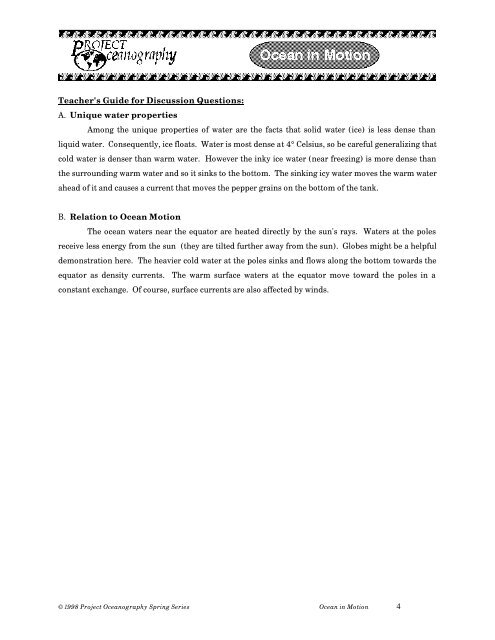Ocean in Motion 2: What Causes Ocean Currents and How Do We ...
Ocean in Motion 2: What Causes Ocean Currents and How Do We ...
Ocean in Motion 2: What Causes Ocean Currents and How Do We ...
- No tags were found...
Create successful ePaper yourself
Turn your PDF publications into a flip-book with our unique Google optimized e-Paper software.
Teacher's Guide for Discussion Questions:A. Unique water propertiesAmong the unique properties of water are the facts that solid water (ice) is less dense thanliquid water. Consequently, ice floats. Water is most dense at 4° Celsius, so be careful generaliz<strong>in</strong>g thatcold water is denser than warm water. <strong>How</strong>ever the <strong>in</strong>ky ice water (near freez<strong>in</strong>g) is more dense thanthe surround<strong>in</strong>g warm water <strong>and</strong> so it s<strong>in</strong>ks to the bottom. The s<strong>in</strong>k<strong>in</strong>g icy water moves the warm waterahead of it <strong>and</strong> causes a current that moves the pepper gra<strong>in</strong>s on the bottom of the tank.B. Relation to <strong>Ocean</strong> <strong>Motion</strong>The ocean waters near the equator are heated directly by the sun's rays. Waters at the polesreceive less energy from the sun (they are tilted further away from the sun). Globes might be a helpfuldemonstration here. The heavier cold water at the poles s<strong>in</strong>ks <strong>and</strong> flows along the bottom towards theequator as density currents. The warm surface waters at the equator move toward the poles <strong>in</strong> aconstant exchange. Of course, surface currents are also affected by w<strong>in</strong>ds.©1998 Project <strong>Ocean</strong>ography Spr<strong>in</strong>g Series <strong>Ocean</strong> <strong>in</strong> <strong>Motion</strong> 4
















